Contents
A runny nose is an inflammation of the nasal mucosa. The medical name for the common cold is rhinitis. A runny nose (or rhinitis) is most often awakened by viruses and microbes.
The mucous membrane of the nasal cavity is the primary barrier against infections, the villi on its surface trap dust and pollution entering the nose during breathing. In addition, the air in the nasal cavity is warmed to a comfortable temperature. Runny nose and colds often occur with hypothermia, local immunity weakens, and infectious agents get the opportunity to multiply and spread further along the nasopharynx and respiratory tract.
Causes of the common cold

A runny nose can occur for various reasons. The most common cause of the common cold are infectious agents – viruses, bacteria and fungi. The most common cause is viruses from the group of rhinoviruses, coronaviruses and adenoviruses. Then the disease is classified as infectious rhinitis.
Another cause of inflammation of the nasopharyngeal mucosa is an allergic reaction. Allergens enter the nasal passages during breathing, causing swelling, mucus secretion and nasal congestion. In this case, the disease is classified as allergic rhinitis.
Allergic and infectious rhinitis require different approaches to treatment – to mitigate the negative signs of the disease in both cases, vasoconstrictors are used, which allows for a short time to ease the patient’s breathing and moderate mucus secretion. However, infectious rhinitis requires complex therapy with the use of antiseptic drugs, and hormonal agents and histamine receptor blockers are used in the treatment of allergic rhinitis.
Possible causes of a runny nose:
Infectious rhinitis. This type of rhinitis is more common than others and is familiar to almost everyone. Infectious rhinitis occurs in an acute form, most often it is caused by bacteria, viruses, less often fungi. If the patient has stable immunity, the infectious rhinitis ends quickly and without complications.
congenital causes. Developmental anomalies in the prenatal period disrupt the normal functioning of the nasal cavity and cause chronic rhinitis. Such causes include violations of the structure of the facial bones, curvature of the nasal septum, hypertrophy or deformation of the nasal cavities. Most often, a one-sided defect occurs when the deformed nostril does not function, and air freely enters through another cavity.
A rare cause of chronic rhinitis is Kartagener’s syndrome. Another name for the pathology is primary ciliary dyskinesia. The disease disrupts the mechanism for removing mucus from the nasal mucosa due to improper functioning of the ciliated epithelium. The result of this is the stagnation of mucus in the nasal cavity and in the bronchi, the development of bronchitis, the transition of rhinitis into a chronic form.
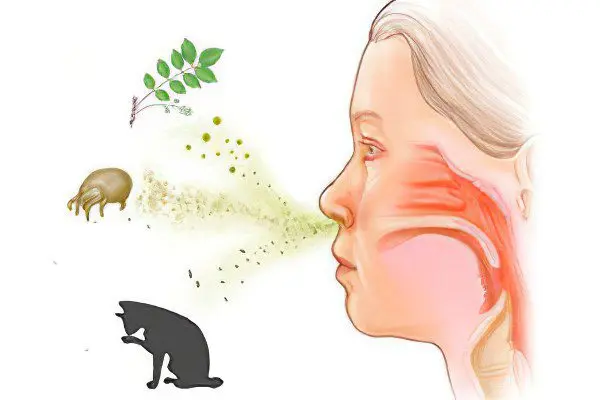
Allergy. One of the most common causes of long-term chronic rhinitis in children and adults is allergic rhinitis. It appears not only at the time of flowering, but also in winter, when, it would seem, there should be no reason for the appearance of an allergy.
Common allergens:
wool of pets;
Down and feather of parrots;
Book, household, industrial dust;
Chemicals in detergents, varnishes and paints.
Medicinal rhinitis. Runny nose, which appeared as a result of taking medications, occurs for two reasons:
Rhinitis is a side effect of a drug (such as blood pressure medications);
There is a rebound effect after an overdose of a vasoconstrictor from a cold.
“Ricochet” rhinitis can develop as early as 4-5 days after the start of treatment for ordinary rhinitis with drops with a vasoconstrictive effect. Untimely cancellation of drops from the common cold leads to addiction to them by the nasal mucosa. Cancellation of the drug leads to increased swelling, increasing the dose leads to the resistance of mucosal cells to the active substance. The result of this situation is the persistence of rhinitis symptoms even at maximum doses. That is why it is not recommended to use vasoconstrictor drops for longer than the period specified in the instructions.
Adenoids. The growth of adenoids, located at the entrance to the nasal cavity from the side of the pharynx, causes chronic rhinitis in children. The hypertrophied palatine tonsil blocks the lumen of the nasal passages, which creates an obstacle to the flow of air. Often there is a combination of hypertrophy of the adenoids with otitis media, sinusitis, chronic tonsillitis. The growth of tonsil tissues provokes the reproduction of pathogenic bacteria that cause inflammation of the tissues of the nasopharynx. Read more: causes and symptoms of adenoids
Foreign bodies. Most often, this cause of an atypical runny nose occurs in children of early preschool age.
The child can imperceptibly from the parents place in the nose:
Small toys and their details;
Pencils;
food particles;
Buttons;
Vitamins and small sweets;
Small stationery and household items;
Parasites (helminths).
A characteristic symptom of a foreign body in the nose is the discharge of liquid mucus from one nostril. With a long-term runny nose, an experienced otolaryngologist always first of all suspects the presence of a foreign body in the nasal passage. A case of chronic rhinitis lasting for 20 years was recorded, the cause of which was a button that got into the nose in childhood. She was discovered in a woman quite by accident during an X-ray examination.
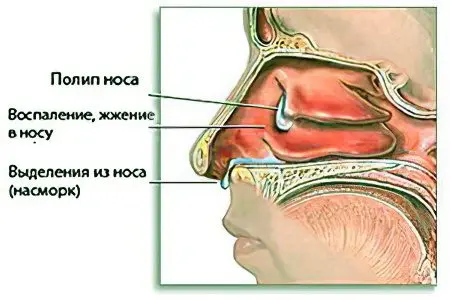
Nasal polyps. Due to chronic inflammation or allergic effects on the nasal mucosa, benign polyps occur. Formations reach a significant size, blocking the nasal cavities and blocking the flow of air.
Most often, polyps form in adults. If they are diagnosed in a child under 10 years old, their possible cause is chronic sinusitis, cystic fibrosis. Often a combination of a polyp with bronchial asthma, an allergy to acetylsalicylic acid or yellow fruits.
Vasomotor rhinitis. The cause of the pathology is a violation of the regulation of the tone of the vessels of the nose. With this pathology, the parasympathetic nervous system is activated, the nerve endings of which exhibit a vasodilating effect. The vessels of the nasal mucosa overflow with blood, swell strongly, air does not pass through the nasal passages. Symptoms of vasomotor rhinitis are sneezing, stuffy nose, secretion of large amounts of mucus. They are aggravated by stress, cold, intense odors, chemicals sprayed into the air, and strong emotions.
atrophic rhinitis. This type of runny nose is rare, its cause is the thinning of the nasal mucosa, its atrophy due to a rare type of inflammatory process. It is provoked by such types of bacteria as Proteus, Klebsiella, as well as hereditary predisposition. Symptoms of atrophic rhinitis – ozena (discharge with a fetid odor), loss of smell, green mucus with the formation of crusts.
Runny nose as a symptom of other diseases. One of the possible causes of a long-term runny nose is latent hypothyroidism – a reduced function of the thyroid gland, insufficient production of hormones by it. For this reason, the connective tissues of the whole body swell, including the nasal mucosa. Due to edema, the air flow decreases, congestion occurs. Clarification of the diagnosis is carried out by passing an analysis for thyroid hormones.
Another reason for the development of chronic rhinitis is autoimmune diseases:
Psoriasis,
Wenger’s granulomatosis
systemic scleroderma,
Rheumatoid arthritis.
Runny nose symptoms
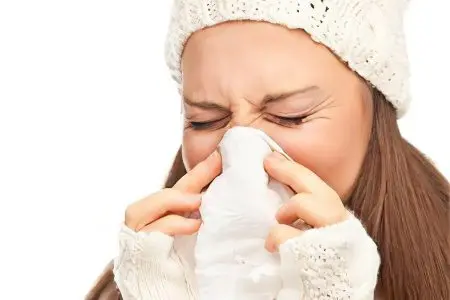
The symptoms of a runny nose differ depending on the stage of the disease:
The first stage lasts from several hours to two days. The patient at this time feels dryness of the mucous membrane, burning in the nose and continuous itching. Already at this time, breathing through the nose is difficult, the perception of tastes and smells is disturbed. The temperature is usually normal, occasionally (more often in children) slight hyperthermia can be observed.
At the second stage the virus actively multiplies, abundant discharge begins from the nose, it is impossible to breathe through the nose. Often, the patient’s ears are blocked, the temperature rises, lacrimation and frequent sneezing begin. The disease is accompanied by headache, loss of appetite and other symptoms.
The third stage occurs 4-5 days after infection. The mucous membrane of the nasopharynx, damaged by viruses, is colonized by various bacteria, as a result of which mucopurulent discharge from the nose appears.
If a person’s immune system is in good shape, the body is activated to fight infection. Puffiness gradually subsides, the sense of smell improves and nasal breathing is restored. After a few days, the person recovers. If a person’s body is weakened, without adequate treatment he may not be able to cope with the disease, in this case the worst thing is that various, including severe, complications may develop.
Runny nose without fever – what does it mean?
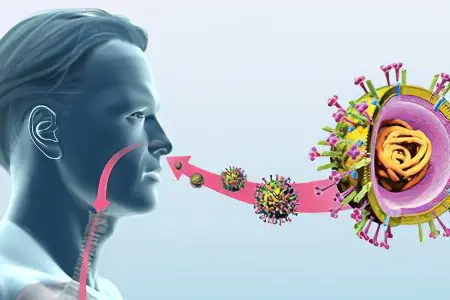
A runny nose that is not accompanied by an increase in body temperature may be a sign of a viral infection, in particular, this is typical for rhinoviruses. Nasal congestion, copious mucous discharge and difficulty breathing are the main symptoms of this disease. Headaches, sore throat, stuffy ears and hearing loss may be added to them. Most often, this type of runny nose appears in adults and is a sign of good immunity, because in the process of fighting the infection, the hypothalamus, where the thermoregulatory centers are located, is not affected.
The cause of a runny nose without fever is hypothermia of the body, as a result of which it becomes more susceptible to infection.
Another reason for the occurrence of a runny nose without fever is the individual characteristics of the patient’s condition. So, rhinitis can appear in women in the first trimester of pregnancy and in young children when their teeth erupt. Treatment in this case is purely symptomatic, since a runny nose is not a sign of a serious pathology, but develops due to weakened immunity.
Factors provoking the development of a runny nose without fever:
Air pollution with dust, toxic and irritating mucous substances. So, allergic rhinitis often develops as a result of constant contact with animals, passive or active smoking, being in a dusty room;
Spicy spices, if they enter the nasal cavity, can provoke irritation of the mucous membrane and in the future cause the development of a runny nose;
Sharp changes in air temperature and humidity – for example, in the cold season, there is often a difference between low air temperature outside and high indoor temperature;
Adenoid growths of the tonsils are a common cause of the common cold in children;
When foreign bodies enter the nasal cavity, a runny nose acts as a symptom, this cause is also more common among children;
Polyps and other neoplasms in the nose, as well as an abnormal structure of the nasal septum, can provoke chronic rhinitis.
How to treat a runny nose?
There are certain rules, following which, you can quickly and effectively cure a runny nose.
How to treat a runny nose in adults?
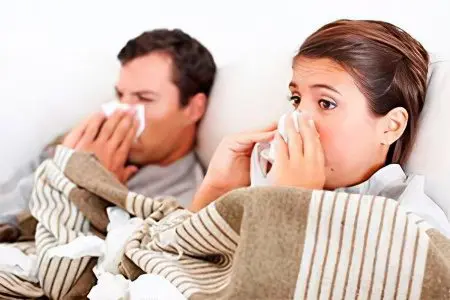
It is important to learn how to blow your nose correctly so that blowing your nose does not lead to complications. An increase in pressure in the nasal cavity can cause bacteria to enter the Eustachian tube. Pathogenic microorganisms can easily cause otitis (inflammation of the middle ear). If you blow your nose incorrectly, you can damage the already irritated membrane of the middle ear. The correct technique is to blow your nose gently through each nostril separately, while opening your mouth so as not to increase pressure in the nasal cavity.
For effective treatment of a runny nose, it is not necessary to irritate the mucous membrane with exposure to cold, tobacco smoke, strong odors, dust, or intense sneezing. Physical activity increases the strength of breathing, so even in the warm season, you can increase the runny nose with fast walking and exercise.
It is impossible to increase the period of use of drugs with a vasoconstrictive effect without a doctor’s prescription. Following the instructions, you can significantly reduce the risk of a “rebound” runny nose from using drops for more than 4-6 days.
Drops on a natural basis such as Pinosol effectively eliminate the symptoms of a runny nose. Its components (essential oils of eucalyptus, mint and pine) act as an antiseptic and anti-inflammatory agent.
Rinsing the nose with salt water removes dust, allergens, excess mucus, pathogens, and dried crusts from the nasal mucosa. This procedure is carried out at least 3 times a day, the optimal amount is 150-200 ml for each nasal cavity.
How to treat a runny nose in children?

It is important to maintain the optimum temperature (+20+22°C) and humidity in the room where the children are. Too dry air in a home with central heating irritates the nasal mucosa, so it is imperative to use humidifiers. Be sure to ventilate the room, taking children out of it.
Children of younger preschool age do not have the opportunity to blow their nose, so the accumulated mucus makes it difficult to breathe with a runny nose. They remove the mucus from their nose with special devices. Rinse the nose in the same way as adults, children are allowed no earlier than 3 years.
Proper treatment effectively relieves the symptoms of rhinitis. Since the nasal mucosa in children quickly absorbs the active substance of the drugs, it is better to use natural-based products. Ointment and drops are used to treat children from 2 years old, spray – from 3 years of age. The drug is not addictive, acts as an anti-inflammatory agent, its natural ingredients and oil base perfectly moisturize the nasal mucosa.
So that adenoids in children do not become a source of complications in the form of relapses of rhinitis and the appearance of complications, they are removed in a timely manner. The spread of pathogenic bacteria slows down the normal physical development of children.
How to treat allergic rhinitis?
The main rule is not to provoke allergic rhinitis by contact with the allergen. Prolonged inflammation of the nasal mucosa is complicated by sinusitis, the appearance of polyps, and mucosal hypertrophy. If the allergen gets on the skin and clothes, they are immediately removed.
To remove allergens from the nasal mucosa, it is washed with 1% saline solution, it is important to carry out this procedure before bedtime.
To prevent complications, modern antihistamines (Zodak) should be taken to help stop the process and prevent it from becoming severe.
How to treat chronic runny nose?

It is necessary to clarify the diagnosis, consult an otolaryngologist.
It is not necessary to provoke an increase in the symptoms of any kind of rhinitis by exposure to smoke, dust, spraying chemicals.
If it is impossible to accurately determine the cause of a runny nose, the patient’s condition will improve markedly by washing the nasal cavity with salted water.
If a runny nose occurs, as a reaction to drugs (pressure drugs, contraceptives), you need to find analogues without side effects;
Somatic diseases, the manifestations of which may be a runny nose, should be carefully treated.
The negative effect of vasoconstrictor drugs for the treatment of rhinitis is eliminated with natural-based drops that do not cause addiction, acting as an antiseptic and anti-inflammatory agent at the same time.
What are the treatments for a runny nose?

In the absence of treatment, a runny nose can lead to serious complications – inflammatory processes in the maxillary sinus, pharyngeal and laryngeal mucosa, acute or chronic otitis media, ethmoiditis.
But how to treat a runny nose? In the early stages of a runny nose, it is recommended to leave the house less often and contact with others. Although a runny nose in itself is not dangerous, but with improper treatment or its absence, it can disable a person for several days or even weeks. Therefore, it is necessary to avoid the spread of infection and create all conditions for a speedy recovery.
Therapeutic measures in the early stages include warming up procedures for the legs, inhalations with medicinal solutions with salt or essential oils, taking a large amount of liquid – tea, lemon drink with ginger, infusion of medicinal herbs, rosehip broth.
You should follow all the rules of hygiene of the nasal cavity and constantly clean it from excess mucus using disposable nosepieces. It is necessary to clean the nasal passages under running water carefully, since increased pressure in the nasal cavity can contribute to the spread of infection, causing otitis media, pharyngitis, laryngitis, and inflammation of the maxillary sinuses. It is necessary to clean the nostrils one by one, since with their simultaneous cleansing there is a risk of damage to blood vessels, the formation of couperose stars.
At the second stage of the disease, if all the preliminary procedures were ineffective, you can start using medications prescribed by your doctor. Vasoconstrictors for emergency treatment of nasal congestion are used for no longer than five days to avoid addiction.
To thin the mucus, it is important to constantly ensure the flow of fluid into the body, and taking drugs with mucolytics also helps in this. Too viscous and thick mucus does not separate well from the nasal cavity, makes breathing difficult and prolongs the time to recovery.
Vasoconstrictor drugs for the common cold

The largest group of drugs are vasoconstrictors, after which the mucosal edema decreases almost instantly and the subjective state of the patient is facilitated. However, vasoconstrictor drugs have their own contraindications and features of use, therefore, in the fight against the disease, one should not rely only on this group of drugs.
Vasoconstrictors are usually released in the form of drops or spray, getting on the nasal mucosa, these drugs constrict the blood vessels, due to which the edema disappears, nasal congestion disappears and the person can breathe normally.
Another useful property of vasoconstrictors is the ability to influence the amount of mucus and the rate of its production, which removes the symptoms of a runny nose. The main active components of vasoconstrictors are naphazoline, xylometazoline, oxymetazoline.
Depending on the main active substance, three groups of vasoconstrictors are distinguished:
Xymelin, Dlyanos, Rinonorm – drops based on xylometazoline, Galazolin in the form of drops, spray or gel – a drug based on xylometazoline, the duration of exposure is up to 4 hours;
Fervex, Nazol, Nazivin – contain oxymetazoline in different concentrations, which allows them to be used to treat the common cold in both adults and children. The validity period is longer – up to 12 hours. There are contraindications for patients with renal insufficiency, women during pregnancy and diabetics.
Naphthyzin, Sanorin – medicines based on naphazoline. The validity period after a single application is 6 hours. The drugs in this group are affordable and do not damage the nasal mucosa. Sanorin is considered one of the safest vasoconstrictors, as it contains natural ingredients (aromatic eucalyptus oil) as excipients, which enhances the therapeutic effect and prevents complications.
Other active components of vasoconstrictors – tetrizoline, fenephril – are used less frequently, but have the same mechanism of action on the nasal mucosa. Read more: vasoconstrictor drops in the nose from a cold
Recommendations of specialists regarding the use of vasoconstrictors:
Nasal drops and sprays are not used every time you feel a stuffy nose, but in critical situations when other remedies do not help;
It is impossible to use vasoconstrictors regularly for self-treatment of the common cold – complex preparations that do not lead to complications and side effects are better able to cope with this task.
If during the use of vasoconstrictors you feel a deterioration in well-being, you should immediately consult a doctor.
Preparations for the common cold are selected and prescribed by a doctor, taking into account the characteristics of the disease – this way the treatment is more effective, and side effects are minimized.
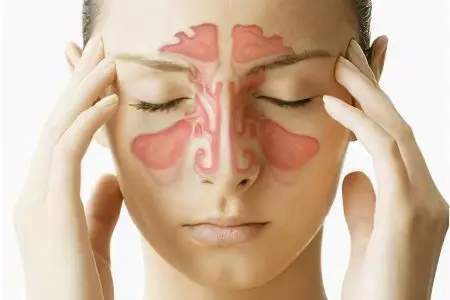
With a runny nose caused by viruses, it is not recommended to take medicines in the early stages – the body must activate the immune forces, and discharge from the nose is a sign of its fight against pathogens. When the snot becomes transparent yellowish or green, treatment can begin.
Therapeutic measures in the early stages of viral rhinitis are aimed at reducing the viscosity of the mucus and its free separation. To do this, it is recommended to drink plenty of fluids, use humidifiers and regulate the temperature in the room where the patient is located. After that, you can start washing with saline, use Pinosol drops and other medicines. Read more: antiviral nose drops for a cold
Salt solutions for colds
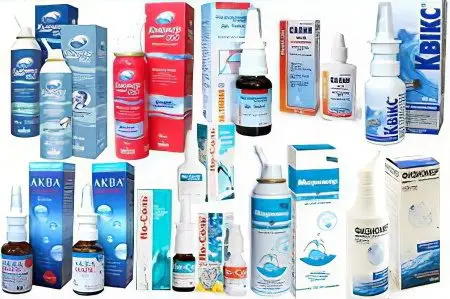
Salt flushing is one of the most effective ways to treat a runny nose. Salt solutions are used for both infectious and allergic rhinitis, as they cleanse the nasal passages of infectious agents, allergens and excess mucus, preventing drying and damage to the mucosa.
Salt solutions have no restrictions in use even for young children, they have no side effects characteristic of vasoconstrictors, they do not form addiction. Common drugs in this group are Aqualor, Salin, Humer, Aquamaris, Marimer.
What can and cannot be done with a cold?

Is it possible to warm your nose with a cold? Warming up the nose can really be useful, as it provokes increased blood flow. This allows you to reduce the recovery time, accelerating the course of inflammatory processes. However, such warming should be done correctly so as not to provoke the appearance of spider veins on the wings of the nose. In addition, it is strictly contraindicated to warm the nose at elevated temperatures. (Read also: high fever – what not to do?)
Is it possible to do inhalation with a cold? Inhalations are considered the most effective method of treating a common cold, so in the process of inhaling vapors, the beneficial components of therapeutic solutions instantly fall on the mucous membrane and have an effect. Compared with other topical agents for the treatment of the common cold, inhalation has several advantages. So, unlike preparations for instillation, during inhalation, the medicinal solution does not flow into the oral cavity and does not enter the stomach, but is evenly distributed over the mucosa, and remains there for exposure.
Modern inhalers (nebulizers) are more effective in treating the common cold. With their help, medicinal solutions penetrate into all corners of the nasal cavity, as well as into the maxillary sinuses and bronchi, which is necessary for the treatment of sinusitis and chronic respiratory diseases. The nebulizer provides the intake of particles of a solution of a certain size (5-8 microns), which is necessary for the most effective impact, while during conventional inhalations, particles up to 10 microns in size and larger, or particles smaller than 5 microns enter the nasal cavity. In the first case, the active substance simply cannot penetrate the nasal cavity, and in the second, the particles are immediately exhaled, and they do not have time to act.
Is it possible to go to the bath with a cold? A visit to the bath will be beneficial only if the runny nose does not occur against the background of an elevated temperature, as well as at an early or final stage of a cold, when the temperature has either not yet risen or has already subsided.
Can I soar my feet with a cold? Hot foot baths for a runny nose can speed up the healing process and can be a great help to the body in fighting infection, especially if the cause of a runny nose is hypothermia. However, it is not recommended to steam your feet with a runny nose if you have an elevated body temperature. Soaring legs is also contraindicated in varicose veins, arterial hypertension.
Which doctor to contact?
With a runny nose, you need to contact the local therapist, general practitioner or ENT doctor. In case of a runny nose for pollen, during the flowering period – to an allergist.









